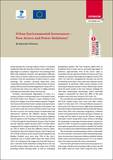Being swamped by receiving millions of liters of untreated wastewater daily, the majority of India’s rivers suffer from a high degree of pollution. Degraded to foul-smelling drains filled with industrial, domestic and agricultural effluents, India’s rivers, no doubt, create serious ecosystem and health problems. Thus, the rejuvenation of India’s rivers is a major challenge. The country’s growing mega-cities show “especially threatening scenarios of deterioration of human quality of life and environmental degradation” (Hust 2005:1). In particular, the urban poor often live in highly polluted, unhealthy and vulnerable urban environments.
Certainly, environmental degradation of rivers is a common problem in fast growing cities of the global South, but North India’s river Yamuna, a major tributary to the wholly river Ganges, is one of the saddest examples. Using the river basin as the territorial unit to analyse water governance “enables us to understand the complexity of the system” and we are able to take into account all kinds of water uses along the river as well as “the variety of types of relationships and interactions” between the different riparian demands (Miranda et al. 2011: 14). The river Yamuna, which originates from the glaciers in the Himalayas of Uttarakhand, flows for 1,376km through Himachal Pradesh, Haryana, Uttar Pradesh and the National Capital Territory (NCT) of Delhi before merging with the Ganges at Allahabad. Thus, at first sight we are able to define at least five different riparian states: Uttarakhand, Himachal Pradesh, Haryana, Uttar Pradesh and NCT of Delhi. However, we also need to include Rajasthan and Madhya Pradesh, since more than 70% of the river’s catchment area is located within these two states (CPCB 2006: 12). Scaling up to the Ganges river basin the Yamuna is just a sub-basin of the watershed. Scaling down to the city level the Yamuna flows 22km via the urban area of Delhi providing surface drinking water as well as recharging groundwater aquifers. The river, however, suffers from an insufficient flow of water and an extremely high degree of pollution. Read the full publication

